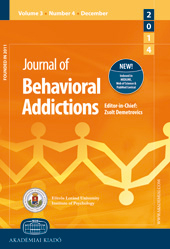Psychometric Properties of the Internet Addiction Test in Turkish
Psychometric Properties of the Internet Addiction Test in Turkish
Author(s): Fatih Kaya, Erhan Delen, Kimberly S. YoungSubject(s): Psychoanalysis, Evaluation research, Substance abuse and addiction, Social Informatics
Published by: Akadémiai Kiadó
Keywords: Internet addiction; Internet addiction test; assessment; evaluation; treatment implications;
Summary/Abstract: In this study, the Internet Addiction Test (IAT) was adapted to Turkish language, which was originally developed by Young (1998) in English to measure the presence and severity of the Internet dependency. The main purpose was to ensure that the psychometric features and the factor structure of the test were suitable for Turkish university students. Method: The study was conducted in two sequent phases. Participants were 990 undergraduate students from several public universities in Turkey. Results: In the first phase, an exploratory factor analysis (EFA) was applied to figure out the factor structure of the Turkish version of the IAT. The EFA revealed four factors, which explained 46.02% of the total variance. In the following phase, a confirmatory factor analysis (CFA) was conducted with a different sample, to verify the factor structure that was found in the initial EFA. The CFA resulted four-factor model was satisfactory for the Turkish version of the IAT. These four factors were named as Mood, Relationship, Responsibilities, and Duration. Conclusions: Based on the findings, the administration of Turkish version of the IAT provided acceptable results on undergraduate students.
Journal: Journal of Behavioral Addictions
- Issue Year: 5/2016
- Issue No: 1
- Page Range: 130-134
- Page Count: 5
- Language: English

